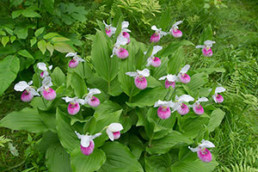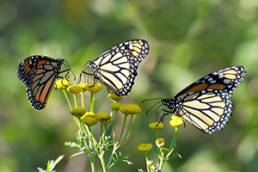Red Robin Tells Shrink Wrap Story
Red Robin Tells Shrink Wrap Story
From my perch on a pine tree branch I’m looking for material to build my first nest. On the ground a snarl of plastic shrink

wrap appears to be the perfect building material. I could build my nest entirely with that mass of plastic. Now if I can only move that plastic pile four flights up into my pine tree. It’s light enough and soft enough, but it swirls around me with the wind, and clings to my every feather. I can’t get off the ground with it wrapped around my wings. I can’t gain control of it. It has control of me.

The plastic nest wasn’t such a good idea after all. I should have stuck with materials from earth like grass and twigs. I’ll flap my way out of this entanglement, but the harder I flutter the more I become shrink wrapped.
© Terry Chick 1/14/2020
Raging Bull Charges Into Lion Pride
Raging Bull Charges Into Lion Pride
The hot and tired twelve member lion pride is curled up under a shade tree at a waterhole in Masai Mara National Reserve. It is
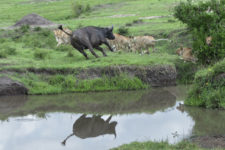
noontime, and night hunting lions are taking their midday nap. The wary matriarch of the pride is not napping. She is alert and staring at a large Cape Buffalo bull who is glaring at her. He’s fed up with the dangerous predators, and wants them out of his territory. At about seventy five yards he is tossing his head from side to side in distain. Then he charges. Lions spring to their feet. Cubs, juveniles and sisters all sprint in one direction, but the experienced matriarch runs in the other direction leading the bull away from her pride. The bull chases her, but he will not catch the speedy lioness. She runs right by our Land Cruiser seemingly knowing the buffalo won’t come near us, and he doesn’t.
This life and death competition between lions and African buffaloes has been going on for thousands of years. The lions prey on young and injured buffaloes, and sometimes even bring down a large adult using a team strategy.

Today the buffalo bull knows the lions are resting, not hunting, and the bull is charging, not giving the lions a chance to get to his rear, and they have no desire for fighting. The noontime sun is hot, and they are tired. An hour earlier the lions were harassing the buffaloes. They had been singling out a buffalo, circling in front of it to occupy its attention, while another tried to attack from the rear, but each time at the last second the buffalo would spin around and front the attacker causing it to veer away.
Now at noontime when the lions are hot and tired the buffalo wants his revenge. He charges right into the middle of the pride sending a message that we don’t like you. You’re not wanted here, and you’re not getting any rest while I’m around. Predator and prey striving for survival on the African savanna.
©Terry Chick 1/3/2020
Skinny Wolf Tries Fat Bear Diet
Skinny Wolf Tries Fat Bear Diet!
What difference does a fat rich salmon diet make to Alaska’s grizzly bears? Take a look at the interior Alaska grizzly bear

compared to the Alaska coastal grizzly bear. 600 pounds is a large interior grizzly in Denali National Park. A large coastal grizzly bear would be 1000 to 1200 pounds. The difference in size is attributed to coastal bears eating a high caloric salmon diet since the ice sheet retreated from coastal Alaska thousands of years ago.

So what took wolves so long to add salmon to their diet? Wolves are carnivores; bears are omnivores like humans. Maybe the carnivore wolves were slow to develop a taste for fish. The skinny wolf at Brooks Camp seems to have taken a liking to salmon. Could it be he was enticed by watching bears feast on salmon?
If this wolf family is successful with their salmon diet possibly we will have giant coastal gray wolves 10,000 years from now!
Given the atmospheric temperature trends in recent decades it is unlikely the wolf will get the 10,000 year opportunity grizzly bears have gotten. This year Alaska’s early summer had record breaking heat and drought. The Brooks River sockeye salmon run was delayed by warm water temperatures. The fish retreated to cooler water until the heat

wave broke, and water temperatures dropped to a point where the salmon could proceed up river.
If this rising temperature trend continues in the future there will be a point where water temperatures will be too high for salmon in this part of the state. Fish are very sensitive to water temperature, and many other species are dependent upon fish. Animals that depend upon salmon runs such as coastal brown bears will have to adapt or relocate, and the skinny wolf will remain skinny!
©Terry Chick 1/1/2020
Bears Are Good Hosts When Humans Use Good Sense
Bears Are Good Hosts When Humans Use Good Sense
They share their trails, their beach and even share the river with anglers in waders. Men and bears in the same river with a common goal: catch salmon! How can bears and people each have a great experience in the same congested space? Since these bears were cubs the river has brought them a feast of salmon. They are focused on fishing. Secondly, the park service at Katmai National Park has an effective peace plan in place: Don’t allow bears to associate people with food. That means do not allow bears to obtain food from people in any way. So food is eaten only in designated eating places, and stored in provided lockers. When visitors deboard their floatplane or boat at Brooks Camp they are directed to the ranger station visitor center for a bear safety orientation. By following a few sensible guidelines bears roam freely, and visitors enjoy the experience of a lifetime.

The safety orientation mentioned juvenile bears can be a handful because they like to wrestle and chase each other at full speed. On one of my daily return hikes from Brooks Falls I noticed a bear running full speed straight at me so I hustled to get off the gravel road as instructed in the orientation. Lucky for me I chose the left side of the road to get out of the way because the two bears, one chasing the other, zoomed into a side trail opposite me. No sooner had they disappeared into the woods they reappeared walking single file by me on the gravel road. The side trail was a u-turn only a bear would know about! I was holding my breath they didn’t turn their attention to me. I was only about 10 feet away from them, but I guess they were so focused on playing they never looked my way. I couldn’t go any further off the road due to a mass of tightly packed small evergreen saplings.

I listened for about a minute of silence, and slowly edged back onto the road. About 50 yards ahead of me a young couple with about a ten year old child had aroused the curiosity of one of the juvenile bears. It was only about six feet from them sniffing the air. The bear walked into the woods. I wondered why they hadn’t gotten off the trail as the rangers had instructed, but they were visibly shaken so it wasn’t the right time to put them on the spot with questions, and I didn’t ask. They said the bear kept sniffing, and seemed to focus on the child. I told them bears use their powerful sense of smell to identify things. The small size of the child may have added to the bears curiosity.
Bear jams occur frequently at Brooks Camp. The third of a mile trail to the campground is only a few yards in the woods from Naknek Lake beach. One evening after photographing bears all day a family of bears was snoozing on the beach so the trail was closed. A park volunteer guided us on an obscure water pipe path to the campground.

On a hike to Brooks Falls a sow and two cubs were playing in front of a patch of fireweed. We started to retreat, but three juveniles were approaching from behind us so we waited. A ranger showed up and had us retreat a few feet into the woods. After a wait the juveniles disappeared into the woods allowing us to continue toward Brooks Camp.
I stayed five awesome days at Brooks Campground. I hiked to Brooks Falls each day to photograph bears catching salmon as they leaped the falls. The bear numbers this year at the falls were reduced due to unusual river conditions. A record breaking heatwave in Alaska raised water temperatures in Brooks River to the point where the sockeye salmon run was delayed. The fish retreated to cooler waters until the heat abated, but the heat and drought also lowered the water level enabling bears to access fish the entire length of the river. Once the salmon run began there wasn’t a need to fish at the falls. There were many locations in the river where bears could fish. Luckily a few bears sporadically kept things interesting at the falls.
Photographing and viewing was excellent from the new Brooks River bridge. It opened just two weeks prior to my arrival, and from my observations over five days the bears had already adapted to it. Boars, juveniles and sows with cubs passed freely under the bridge and paid no attention to people above. I photographed juveniles wrestling, bears fishing and sows nursing spring cubs from the bridge viewing platforms. Occasionally the action was directly below, but usually it was sufficient distance from the bridge to get excellent photographs.
This was my third trip to Brooks Camp and by far the most memorable. Time after time bears were carrying out their behavior in front of one of the bridge viewing platforms. The bears seem to know the bridge separates them from people, and the 1200 foot span allows people to be securely in the middle of bear action.
©Terry Chick 2019
Monarch Butterfly Born In My House
Monarch Butterfly Born In My House
When I noticed a solid green monarch butterfly chrysalis on my lawnmower shed October 2nd in Maine I feared it would be too cold for it to develop into a butterfly. As the weeks went by the weather was cold and rainy with little sun. I noticed the chrysalis was still solid green on October 22nd.

There would be few days ahead with sufficient temperatures for a monarch. Maybe if I brought the chrysalis into my house it would metamorphose into a butterfly. So using a razor knife I detached the chrysalis from the eave, brought it into the house and glued it to a small piece of wood with a hot glue gun. Next, I placed the wood over the opening of a jar with the chrysalis hanging in the jar.
With the 69 degree indoor temperatures the metamorphoses speeded up. The next morning I could see the dark color of a monarch inside the chrysalis, and by evening it was fully developed. It was ready to emerge. At 6:00am it looked the same as the evening before, but I returned at 6:30 to see it completely emerged and attached to the wood turning its body side to side drying. This can take hours outside, but in a warm, dry house it happened faster than I expected. It was on the window sill!
The weather was too cold that day, but should be about 58 the next day. I hoped he would stay calm in the house for one day, and he did. The mornings are slow to warm in late October so I waited until 10:00am when the sun would begin to strike the only live aster remaining in my yard. I nudged my hand into the monarch’s legs, and he (it was a male) attached to the back of my hand. He stayed with me out the door and around to the back yard. I nudged him to the aster, and he attached.
The sun was only partially striking the aster due to large trees. His wings where reacting to the strength of the sun. As more rays became free of the trees his wings would open wider, and when the rays went back behind branches his wings would close a bit. By 10:30 the full sun was striking his wide open wings, and he departed south heading for Mexico.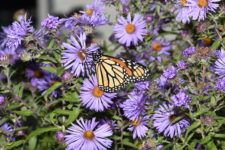
Could the descendants of my monarch find their way back to my yard next summer after three generations had passed, and even though they have never been here? That possibility is not a lot different than the fact that my monarch born in my house, and all others born in the north will find their way to the Sierra Madre Mountains of Mexico to spend the winter even though they have never been there before. It seems plausible.
In The Path of a Williwaw
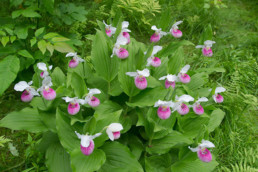
In The Path Of A Williwaw
What had been a sunny pleasant day turned breezy as clouds began building over the southeast horizon of the Bering Sea. I decided to make my way back along the westerly shore of uninhabited Anangula Island to my tent after a productive day photographing birds and wildlife. American black oystercatchers were sitting on their eggs on open rocks, sea otters floated on their backs in the Bering Sea, and bald eagles flew overhead, but the surprise came when I reached the cove entrance. The steep walls of the cove funneled a forty mile per hour wind straight at me. I leaned into the wind and pushed my way toward the head of the cove. The weather is changing, and it’s apparent it’s going to be for the worse.
The narrow cove is several hundred yards long, and my Northface VE 24 dome tent was situated on a narrow flat area between a small beach and a thirty foot vertical grassy wall. A fresh water spring and brook entered the ocean here and had carved a small trough through the island.
To help with the wind I moved some stones from the beach into the tent, and quickly ate dinner while a heavy mist began to fall. As the evening progressed the wind became scary so I put on all my warm clothes and rain gear in case the tent shredded. At 8:30 PM a sound like an incoming missile traveled over the island through the trough and slammed into the top of the tent crushing it down two feet. In the next instant the shock-cords snapped the tent back into position with a loud shudder similar to the sound of a large flag flapping in a gale. As the wind got stronger and stronger I became fearful it would carry the tent, me and my belongings into the sea so I ran outside and brought larger rocks into the tent. I placed the rocks, gear, and me on the windward side and held onto the poles hoping to prevent them from snapping. The williwaw whistle and blast smashed the tent every thirteen seconds lifting the windward side two feet off the ground while at the same time crushing the top of the tent downward. I kept thinking how much stronger is this wind going to get and will it sweep me into the sea. The williwaws and hurricane force winds went into the next morning. The last williwaw struck at 830 AM. I had been hanging on to the tent all night and somehow the tent had made it through dry and undamaged.
The next day rain and strong winds continued over the Bering Sea, but the storm center had moved to my campsite side of the island so williwaws were no longer a threat. I was now on the windward side of the storm so if there were williwaws they would be landing on the opposite side of the island. I spent the day trying to catch up on my sleep. Many of the Bering Sea islands are hills or mountains jutting abruptly from the sea. This wind barrier causes pressure to build on the windward side and periodically leap over the island to the lower pressure side. In my situation the pressure release was following the small valley created by the brook which ended at the beach where my tent was set up. It was a beautiful location for a tent site in average weather, but during a hurricane it was in the path of a williwaw.
The following day the rain let up, but there was heavy overcast and not much light for photography. My local guide had loaned me a communication radio that required line of sight so I hiked to the easterly shore facing the town of Nikolski on nearby Umnak Island. I was not able to reach anyone. The ocean was too rough for the guide’s boat, but I wanted to let him know I was okay. I decided to explore that coastline. It had high cliffs dropping into the ocean with very little access to the water. All the while I moved along that coast a falcon protecting its nest battled a bald eagle. The falcon was faster and nimbler than the eagle and able to dart in and make contact. The eagle on occasion would go into a tumble with talons outstretched in an attempt to grab the falcon. They were still battling when I turned to make my way back to the tent.
The grassy wall lining one side of the cove was home to hundreds of tufted puffin burrows. Their chicks have hatched, and the parents must fly to sea to catch fish. Hundreds of them return at the same time filling the sky over my tent with tufted puffins. Like planes stacked up over an airport they circle to gain their bearings before crash landing into the grass hopefully at the correct burrow. Their flight path is right over my tent, and it is something to see, but even more memorable is the unforgettable sound of hundreds of wings flapping over the tent as they circle the cove numerous times before deciding where to land.
I gathered my water jugs and filter and was kneeling in the tent door looking out the cove to the ocean beyond contemplating: “The sun has returned, but it’s still too rough for a small boat three days after the storm. The Bering Sea is notorious for bad weather how long would it before the ocean flattens enough for the guide to could get out here?” At that moment I heard a loud smack and about ten feet in front of me a saw a blur. As things settled and my vision focused. The blur was a rabbit. I looked up expecting to see a bald eagle, but I saw a sea gull about forty feet over head! The rabbit dragged itself into the reeds. I decided to give it some space for a chance to recover from the fall, and I headed for the spring to fill my containers. When I returned I looked in the reeds and the rabbit had died.
Dressing, skinning, and outdoor cooking are something I grew up with on a small scale. We had a few farm animals, and I hunted whitetail deer and small game from childhood. I built a fire pit from the shore rocks, and gathered driftwood to burn. Once the wood had burned down to hot coals I cooked the rabbit.
In the 1930’s the U.S. government released rabbits on the island to feed foxes liberated in the 1910’s in an attempt to establish a fur trade for local Aleuts. The foxes were removed in the 1940’s because they were threatening native bird populations. The rabbits remain on the island. Anangula is also an important archeological site. The earliest evidence of human activity in the Aleutians was discovered there with artifacts dating 8400 years old.
The next day on the edge of the grassy wall overlooking my tent a European rabbit was posing for my lens when I heard the sound of an outboard motor in the distance. Soon my guide was landing on the beach at my tent. I think he was as relieved to see me as I was to see him. It had been an unforgettable island adventure. More than I had bargained for, and memories that will last forever.
Monarch Butterfly Migration
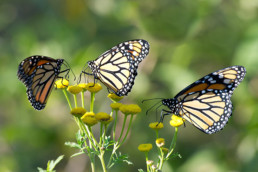
North American
Monarch Butterfly Migration
The monarch butterflies seen flitting about northern backyards during September are on their way to the Sierra Madre Mountains in Mexico to roost in sacred fir trees (abies religiosa). These monarchs have never been to Mexico, but they will fly there from northern United States and southern Canada to spend the winter. In late winter they will leave Mexico on their northern migration to the southern Gulf States to lay their eggs and then die. This new generation will move a bit northward as spring emerges to the middle part of the country. They will lay their eggs at the end of a short two month lifespan. It will take two or three generations of these short-lived butterflies over the course of spring and summer to make their way northward all the way back to northern United States and Canada to complete their annual lifecycle journey.
The special generation born in the north is unique in the monarch life cycle. Their lifespan of seven months is more than double the two month lifespan of generations born in the south, and to facilitate their long flight their wings are longer and sleeker than other monarch generations. Unlike the multiple monarch generations that follow the warming weather of spring and summer northward and spread out randomly across the north, the southbound monarchs have an instinctive singular goal to rendezvous with millions of monarchs in one general area of central Mexico. Most of the monarchs living east of the Rocky Mountains will make the fall trip to Mexico. They will cluster there on tree branches until late February then begin the northern segment of their migration.
If you have milkweeds you could have a monarch emerge from its chrysalis in September, and begin its journey to Mexico from your yard.
© Terry Chick, July 14, 2010

